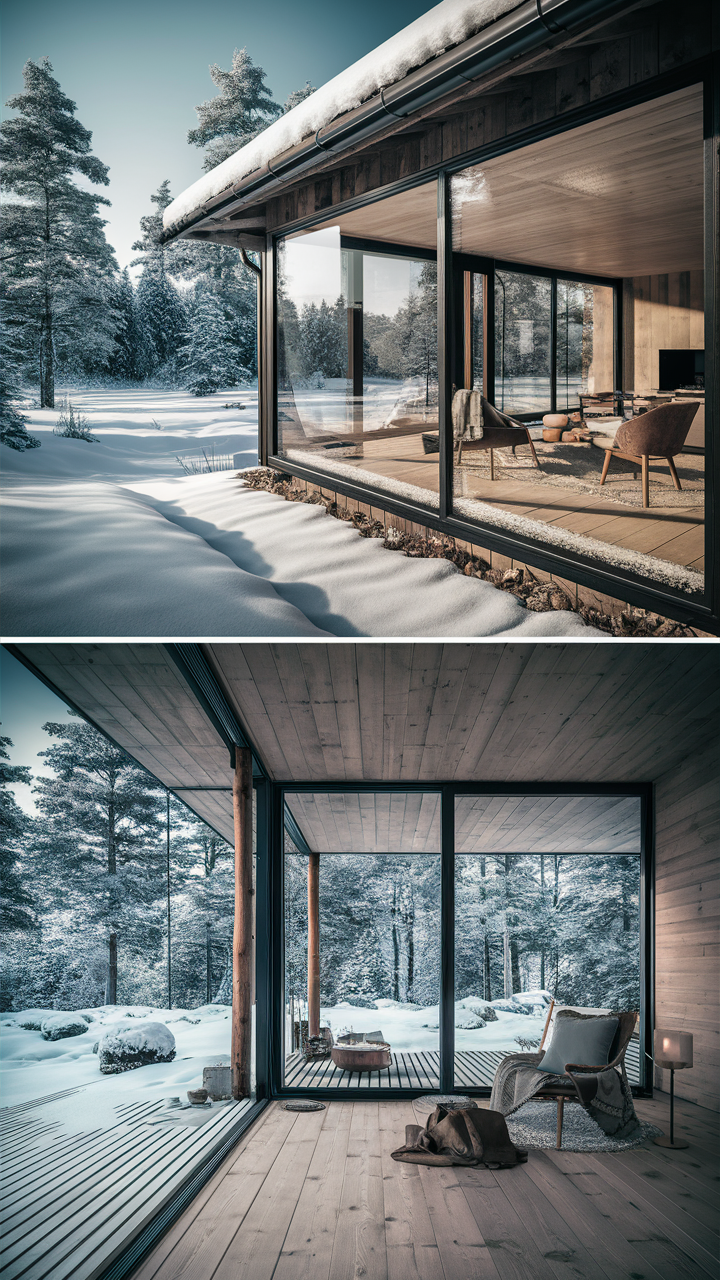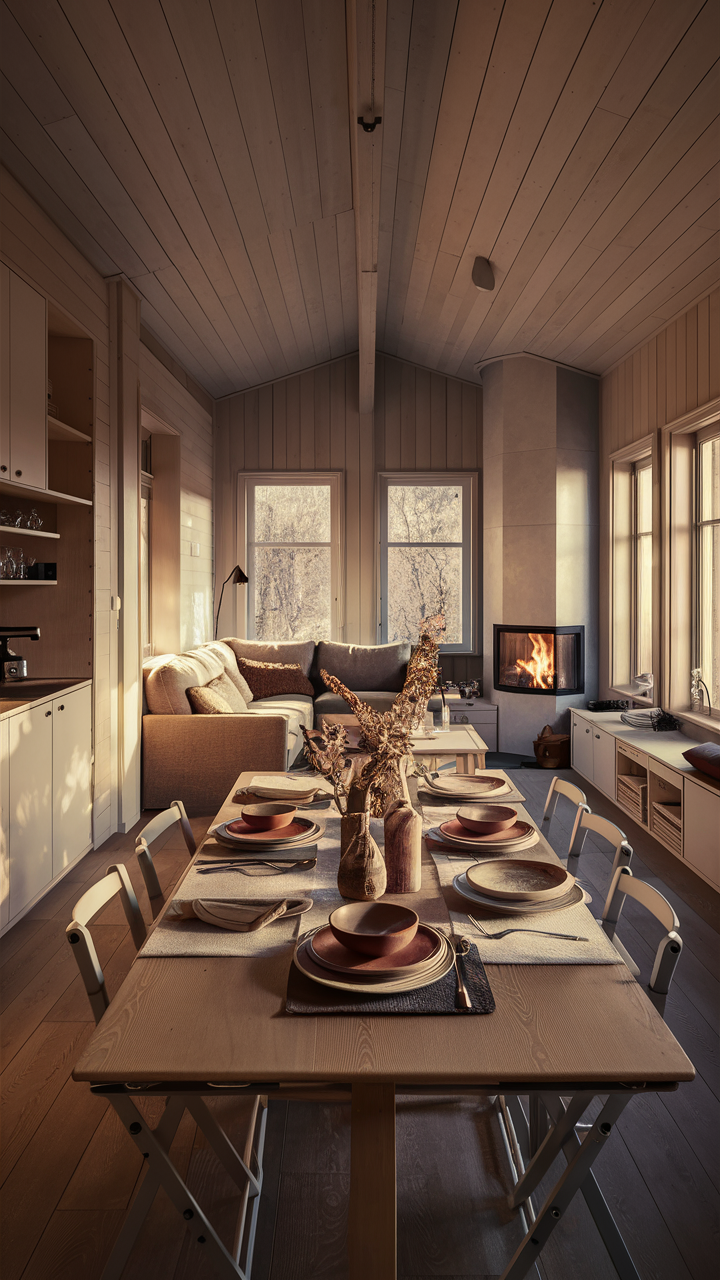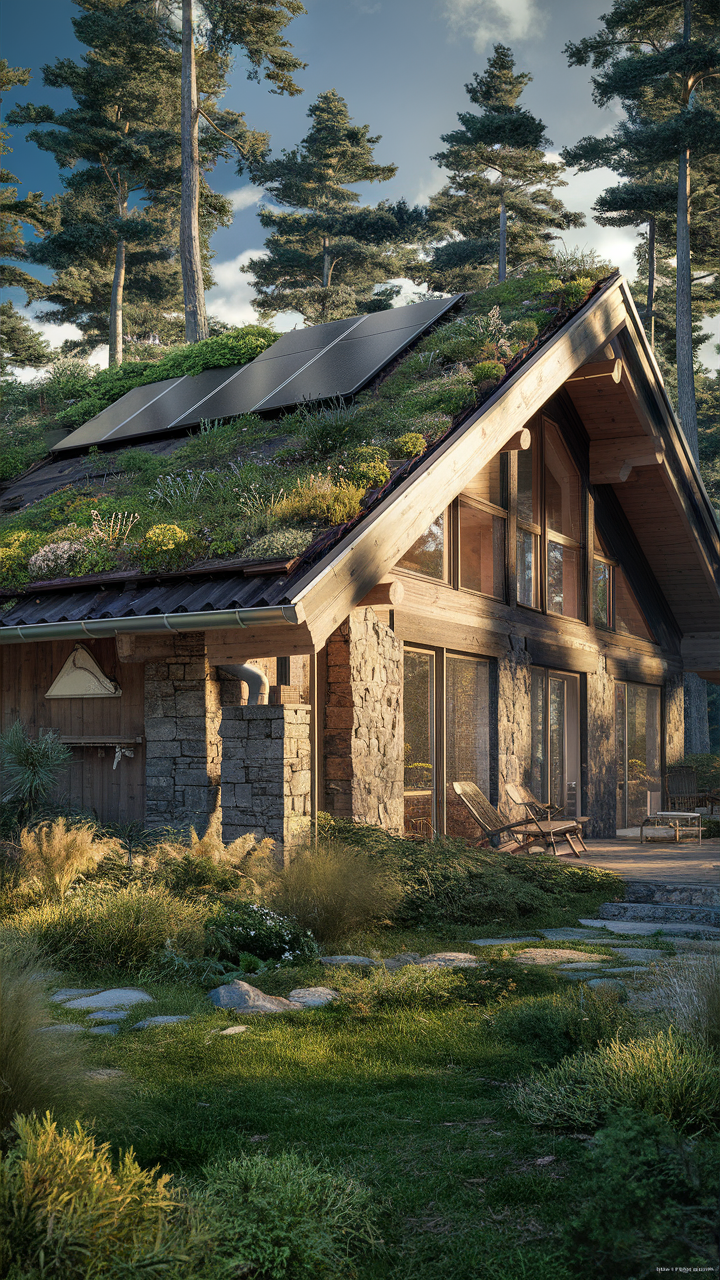Introduction
Finnish cabin houses, epitomizing contemporary Finnish architecture, harmoniously blend modern design with the lush natural landscapes of Finland. These homes are renowned for their minimalistic aesthetics, which not only prioritize functionality and comfort but also integrate seamlessly with their surroundings. Central to this design philosophy is the use of natural materials like wood and stone, which enhance the tranquility of the interior space. Large windows are a staple, extending inviting views of the outdoors and flooding the interiors with natural light, thereby strengthening the connection between indoor and outdoor living spaces.
The core principles of Finnish cabin house design include simplicity, functionality, and sustainability—elements that reflect a profound respect for nature. Architects and designers focus on eco-friendly features such as energy-efficient solutions and sustainable materials, which are evident in the widespread use of light wood and green roofing. Every aspect of these homes, from the compact, multi-functional spaces to the energy-efficient solutions, is thoughtfully designed to enhance living while minimizing environmental impact. This approach not only meets the practical needs of the owner but also provides a serene retreat that embodies the essence of Nordic living.
Key Takeaways
- Finnish cabin houses integrate contemporary design with natural surroundings, employing minimalistic aesthetics and materials like wood and stone to enhance tranquility.
- Large windows are central to Finnish cabin house design, connecting the indoors with the outdoors and maximizing natural light and panoramic views.
- The design of Finnish cabins is governed by principles of simplicity, functionality, and sustainability, ensuring each space is both practical and environmentally friendly.
- Multifunctional spaces and compact layouts are emphasized in Finnish cabins, maximizing utility and comfort within minimal square footage.
- Finnish cabin houses incorporate eco-friendly features such as green roofing and energy-efficient solutions, aiming for minimal environmental impact.
- The decor and furniture in Finnish cabins embody Nordic minimalism, focusing on functionality with a light, airy aesthetic that complements the serene environment.
Elements of Finnish Cabin House Design

Finnish cabin houses, designed with modern Finnish aesthetics, masterfully integrate wooden elements and large windows into the building structure. These homes merge modern design with the natural environment, using materials like wood and stone that highlight their minimalist appeal. The large windows do not just bring in sunlight but also create a seamless flow between the interior and exterior spaces, enhancing the home’s cozy yet functional appeal. These elements are crucial in forming spaces that feel both expansive and intimate, maximizing the enchanting Finnish landscapes and their distinctive cultural essence.
Key Elements and Design Principles of Modern Finnish Cabin Houses
| Feature | Description | Impact on Design |
|---|---|---|
| Wooden Elements | Predominantly used in structure and aesthetics, providing a natural look that complements the environment. | Enhances the minimalist appeal and warmth of the interior. |
| Large Windows | Integral to the design, these maximize natural light and create a seamless transition between inside and outside spaces. | Blurs the boundaries between the home and nature, enhancing spatial perception. |
| Stone Accents | Employed in both exterior and interior designs to add texture and resilience against the elements. | Contributes to the durability and natural aesthetic. |
| Sustainability | Focus on eco-friendly materials and energy-efficient designs such as solar panels and green roofs. | Reduces environmental impact and promotes sustainable living. |
| Integration of Native Plants | Landscaping that includes native flora to maintain ecological balance and enhance aesthetic appeal. | Strengthens the connection with the local environment and supports biodiversity. |
| Outdoor Living Spaces | Designed to extend the living area into the natural surroundings with features like terraces and outdoor kitchens. | Encourages outdoor activities and closer interaction with nature. |
This table organizes the essential elements and design principles of contemporary modern Finnish cabin house design, providing an informative overview that relates closely to the initial discussion on how these homes integrate into their natural surroundings and the philosophy behind their architectural choices. By focusing on both the aesthetic and functional aspects, the table enriches the understanding of Finnish cabin design and its cultural significance.
Finnish Cabin House Design Principles and Philosophy
The design of Finnish cabin houses is deeply rooted in a philosophy of harmony with nature, focusing on simplicity, functionality, and sustainability. Large windows are strategically used to blur the boundaries between the indoors and the natural world outside, making these homes feel like an extension of the landscape. This approach ensures that every aspect of the cabin’s design contributes to a tranquil, practical living space.
Incorporating Nature into Finnish Cabin House Design
Finnish cabins are designed to maximize interaction with their natural surroundings, using large windows to provide panoramic views that bring the outdoors inside. The integration of native plants and the creation of outdoor living spaces are deliberate, aiming to blend the cabin naturally with its environment. This design philosophy ensures a seamless flow between the cabin and the landscape, enhancing the overall experience of connection with nature.
Minimalist Aesthetic in Finnish Cabin Houses

Finnish cabin houses, a project of minimalist design, celebrate simplicity with clean lines and uncluttered spaces that enhance functionality and comfort. The interiors, often featuring a neutral grey color palette and wooden surfaces, radiate tranquility, making each space feel serene and purposeful. This approach ensures every element, from the kitchen to the sauna, serves a practical purpose, fostering a calm and cozy atmosphere. The design, influenced by Alvar Aalto‘s principles, emphasizes contrast in textures and integrates natural materials, aligning with the residential and collective spirit of Helsinki.
Key Features of Minimalist Aesthetic in Contemporary Finnish Cabin House Design
-
Simplicity and Clarity: Emphasis on clean lines and uncluttered spaces that enhance both functionality and comfort, reflecting the minimalist principles of famous Finnish architect Alvar Aalto.
-
Use of Natural Materials: Extensive use of materials like wood and stone, which not only provide functionality but also blend seamlessly with the natural landscape, supporting the serene and earthy color palette.
-
Functional Furniture: Every piece of furniture is designed to serve a specific, practical purpose, enhancing the usability of each space while adhering to the minimalist aesthetic that emphasizes utility over decoration.
-
Integration of Nature: Design strategies that incorporate elements of the natural environment, such as large windows for natural light and native plants for landscaping, to foster a strong connection between indoor and outdoor living spaces.
-
Sustainable Design: Focus on sustainability through the use of eco-friendly materials and energy-efficient technologies, aligning contemporary design with ecological responsibility.
This list builds on the concept of minimalist aesthetic in contemporary Finnish cabin house design by highlighting key features that are essential to creating spaces that are not only visually appealing but also functional and environmentally conscious. Each point elaborates on the original elements to provide a deeper understanding of how simplicity and functionality are achieved in these modern homes.
Simplicity and Functionality in Finnish Cabin House Interiors
Finnish cabin house interiors are crafted with a focus on uncomplicated, practical designs that prioritize comfort and usability. The spaces are intentionally devoid of unnecessary decorations, adhering to a minimalist aesthetic that emphasizes clean, uncluttered environments. This design philosophy ensures that every item within the home has a purpose, effectively eliminating any form of clutter and enhancing the peaceful ambiance.
Natural Materials and Colors in Finnish Cabin House Design
In Finnish cabin house design, the extensive use of natural materials such as wood and stone helps to integrate the structures seamlessly with their natural surroundings. These materials are chosen not only for their functionality but also for their ability to harmonize with the landscape, using warm earth tones and neutral colors that echo the external environment. The incorporation of organic textures and colors contributes to creating a serene, naturalistic atmosphere inside the homes.
Efficient Use of Space

Finnish cabin houses are masterfully designed to maximize space through compact layouts and multifunctional areas, reflecting the vision of Alvar Aalto, a founder of modern Nordic architecture. These homes incorporate clever storage solutions and rooms that often serve dual purposes, ensuring no space is wasted and maintaining a clutter-free environment that is both practical and aesthetically pleasing. The design employs a variety of materials, clad in steel and wood, to inspire functionality and comfort, showcasing a photography-worthy interplay of light and shape, perfect for those who dream of a seamless blend of indoor and outdoor living.
Compact Layouts and Multi-Functional Spaces in Finnish Cabin Houses
In Finnish cabin houses, the emphasis on adaptable spaces is key to their functionality. Living areas are designed to be versatile, with living rooms that can transform into sleeping quarters and tables that serve both dining and work purposes. This flexible use of space is crucial for maximizing utility in compact environments.
Maximizing Natural Light and Views in Finnish Cabin House Design
Large windows are a hallmark of Finnish cabin house design, strategically placed to draw in natural light and frame the stunning external views of forests, lakes, and landscapes. This thoughtful design not only enhances the visual appeal of the interiors but also strengthens the connection with the outdoors. The integration of indoor and outdoor spaces is seamlessly executed to amplify the living experience in these homes.
“Form must have a content, and that content must be linked with nature.” – Alvar Aalto
Sustainability and Eco-Friendly Features

Finnish cabin houses prioritize eco-friendliness, employing energy-efficient solutions and sustainable materials, including green roofing, which significantly reduces environmental impact. These homes seamlessly blend with the natural environment, enhancing eco-friendly living and demonstrating a complete function of design that prioritizes sustainability. The use of natural photography to capture this harmony, and features like running water systems and insulated walls and floors, ensures each house consists of elements that conserve energy while maintaining privacy and comfort.
Key Sustainability and Eco-Friendly Features in Contemporary Modern Finnish Cabin House Design
-
Energy-Efficient Solutions: Finnish cabin houses are designed with thick insulation and triple-glazed windows to maintain temperature and reduce energy consumption. Renewable energy sources, such as solar panels, are commonly used to further minimize the carbon footprint.
-
Green Roofing: The use of green roofing provides excellent insulation, reduces energy costs, and promotes biodiversity by integrating vegetation into the building structure. This not only enhances the aesthetic appeal but also contributes to environmental sustainability.
-
Sustainable Materials: Reclaimed wood and stone are frequently used in Finnish cabin houses to lower environmental impact. These materials are durable, eco-friendly, and help the structures blend seamlessly with the natural surroundings.
-
Heat Recovery Systems: These systems are incorporated to improve heating efficiency, ensuring that minimal energy is wasted. They help maintain a comfortable indoor environment while conserving energy.
-
Integration with Nature: Finnish cabins are designed to harmonize with their natural environment, often featuring large windows to maximize natural light and views of the landscape. This connection with nature promotes an eco-friendly lifestyle and reduces the need for artificial lighting.
This list highlights the key sustainability and eco-friendly features that are integral to contemporary modern Finnish cabin house design, emphasizing the importance of energy efficiency, sustainable materials, and integration with the natural environment.
Energy-Efficient Solutions in Finnish Cabin House Construction
Finnish cabin houses often feature thick insulation and triple-glazed windows. Renewable energy sources like solar panels are common. Heat recovery systems improve efficiency. These solutions reduce energy consumption and ensure a sustainable living environment.
Green Roofing and Sustainable Materials in Finnish Cabin House Design
Green roofing in Finnish cabin houses provides excellent insulation. It also promotes biodiversity. Sustainable materials like reclaimed wood and stone are common. These choices lower environmental impact and enhance the natural aesthetics of cabins.
Embracing Simplicity in Finnish Cabin House Decor
Finnish cabin house decor is a celebration of simplicity, where clean lines and uncluttered spaces foster a tranquil environment. The use of natural materials like wood and stone, prevalent in designs from the design studio, creates interiors that feel both soothing and grounded. Functional furniture, crafted to enhance both the aesthetics and practicality of the space, reflects a blend of inspiration and purpose, with each piece serving a specific role within the home’s serene villa setting.
Nordic Style Furniture and Decor in Finnish Cabin Houses
Finnish cabins prominently feature Nordic style furniture, which embodies functionality and minimalism. Decorative elements are characterized by simple, clean lines and natural wood finishes that reflect the serene Finnish landscape. Light colors are predominant, contributing to a bright and airy atmosphere that harmonizes beautifully with the surrounding nature.
Creating a Cozy and Inviting Atmosphere in Finnish Cabin House Interiors
The interiors of Finnish cabins are designed to maximize warmth and comfort, making extensive use of soft textiles like wool and faux fur. Fireplaces often act as the central focal point, adding both warmth and a sense of gathering to the space. Layered lighting is strategically used to create an inviting ambiance, setting the stage for relaxation and coziness in every corner.
- Mark My Time Reading Timer and Book Mark for Kids
- Cool Bookmarks and Reading Incentives
- Great Christmas Gift & Stocking Stuffer for Book Lovers
- Purple
Conclusion
James Dunnington leads the James Dunnington Collection, featuring five unique blogs: a practical Pet Care Guide, an enlightening Ancient History Blog, a resourceful Home Improvement Guide, a cutting-edge Tech Innovation Guide, and a strategic Online Money Making platform. Each site delivers valuable insights designed to empower and inform. For updates and more tips, visit our Contact Us page to sign up for our newsletter, ensuring you never miss out on the latest content from any of these dynamic fields.

